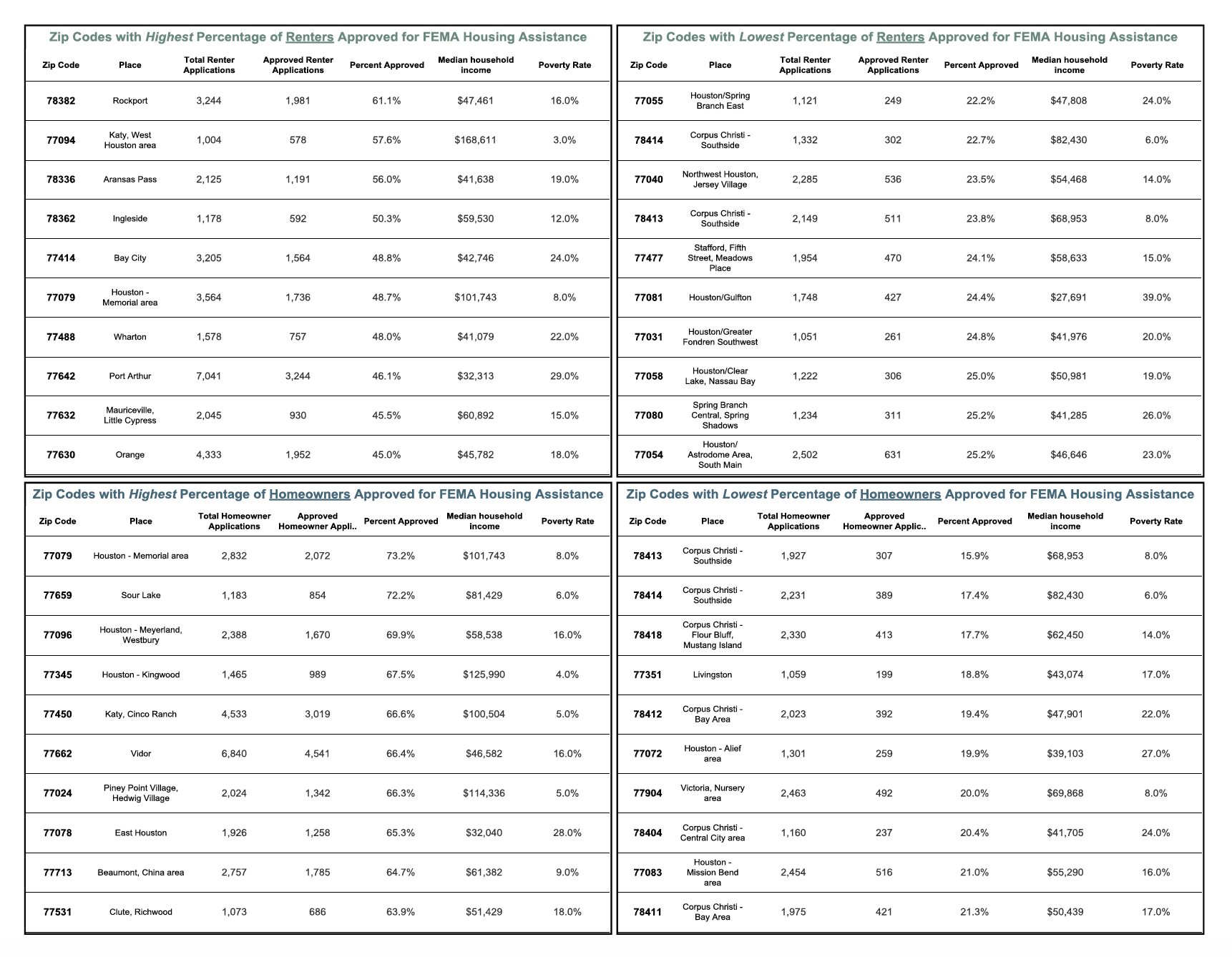HOUSTON – (December 19, 2017) – The zip codes with the lowest percentage of homeowners approved for Federal Emergency Management Agency (FEMA) housing assistance following Hurricane Harvey include more areas with lower household incomes, compared to zip codes with the highest percentage of FEMA approvals. The same was generally true for renters, but the highest FEMA approval rates for renterswere substantially lower than those for homeowners. Those are a few of the findings from a new Episcopal Health Foundation (EHF) analysis of more than 894,000 FEMA applications across 41 Texas counties.
EHF’s analysis found that the five zip codes with the lowest rate of FEMA approvals for homeowners were in the Corpus Christi area (78412, 78413, 78414 and 78418) and Livingston (77351). The FEMA approval rate for each zip code was below 20% and the average median household income was $61,000.
In comparison, FEMA records show that Houston’s Memorial area (77079), Sour Lake in Hardin County (77659), Houston’s Meyerland area (77096), Kingwood (77345) and Katy/Cinco Ranch (77450) had the highest percentage of homeowners approved for FEMA assistance – above 67%. The average median household income for those zip codes was $93,000.
“We don’t know all the specific reasons for approvals or denials, but the numbers show many lower-income communities were less likely to be approved for FEMA assistance than some of the higher-income communities,” said Elena Marks, EHF’s president and CEO. “Recovery efforts need to use this kind of data to not only best decide where assistance should go, but also what types of different help may be needed in different communities.”
For example, Marks says lower-income neighborhoods may need more specific assistance in filing appeals to FEMA decisions or applying for other government and philanthropic recovery programs.
Approval rates for renters vs. homeowners
EHF’s analysis found that in the zip codes with the highest FEMA approval rates, renters were approved at lower rates than homeowners. For example, Houston’s Memorial area (77079) had the highest FEMA approval rate for homeowners at 73%. For renters, Rockport (78382) had the highest FEMA approval rate at just 61%. In fact, FEMA approved at least 63% of homeowner applications in each of the 10 zip codes with the highest approval rates.
FEMA records show the highest percentage of renters approved for housing assistance were in Rockport (78382), Katy/West Houston (77094), Aransas Pass (78336), Ingleside (78362) and Bay City (77414) — above 48%.
FEMA records show Spring Branch (77055), Corpus Christi (78413 and 78414), Northwest Houston/Jersey Village (77040) and Stafford/Meadows Place (77477) had the lowest percentage of FEMA approvals for renters – below 25%.
Additional information
EHF’s analysis examined FEMA data for zip codes across 41 Texas counties that had at least 1,000 FEMA applications for assistance following Hurricane Harvey. FEMA’s data was last updated on December 5.
In addition to the analysis of approvals for FEMA housing assistance, a recent Episcopal Health Foundation/Kaiser Family Foundation survey found nearly half of affected Texans say they are not getting the help they need to recover from the storm. Survey results show that 66% of residents across the 24 hardest-hit counties say they suffered property damage, employment disruptions and/or lost income due to Hurricane Harvey.
The EHF/KFF survey also found about four in 10 (42%) of affected residents say they applied for financial assistance from FEMA or the Small Business Administration (SBA).
Among those who applied, one quarter (26%) say their application was approved and one-third (33%) say it was denied. The remainder say it is still pending (19%) or they are not sure (16%). Among those who were denied, four in 10 (38%) say they were not given a reason, and six in 10 (60%) say they were not given information on how to revise and resubmit their application.
EHF has also developed an interactive scope of damage map with layers of information about Harvey-affected counties. The information includes FEMA property damage assessments combined with the Center for Disease Control’s social vulnerability index data that explains the resilience of communities when faced by stressors such as natural disasters.
“We’re concerned that the voices of the most vulnerable may not be represented during decisions on how to invest Harvey recovery funds,” Marks said. “We continue to provide solid data that recovery efforts can use to discover the issues that Texans from many different communities are still facing. Then, government and other funds can use that information when deciding where resources are needed most.”
###
To schedule an interview with Elena Marks, contact Brian Sasser at bsasser@episcopalhealth.org or 832-795-9404.
